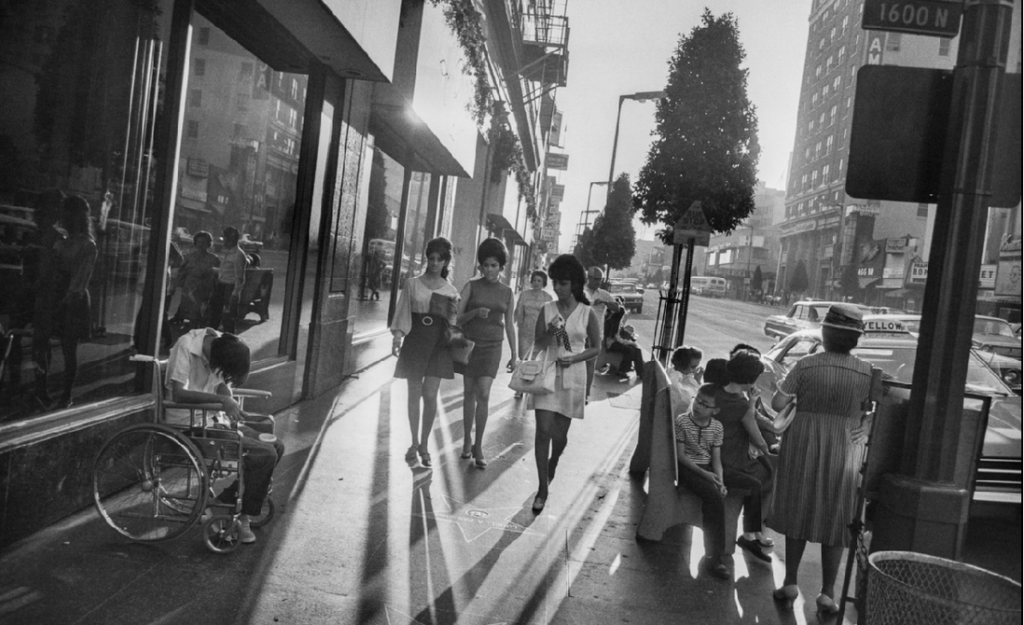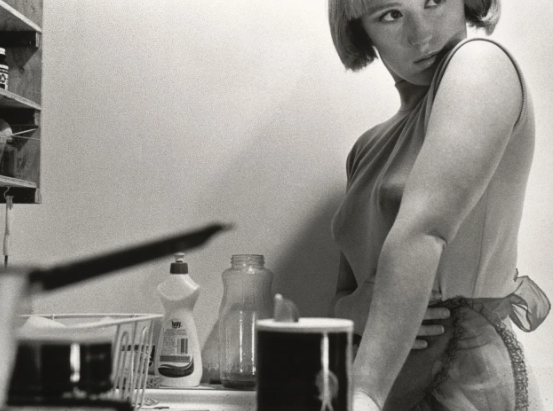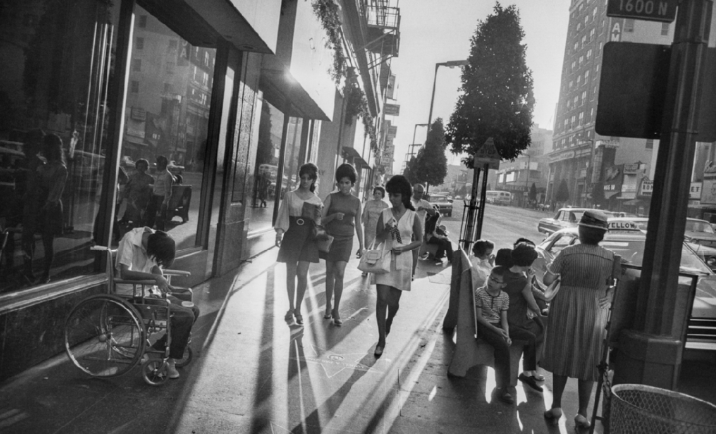Within the origin of photography, there is two photographic processes; Daguerreotype and Calotype. The main difference between the daguerreotype process and Talbot’s calotype process was reproducibility. The calotype process first produced a photographic ‘negative’ in the camera, from which many ‘positive’ calotype prints could be made, whereas daguerreotypes were a one-off image. The calotype was first created by Henry Fox Talbot. He created images when exposed to light, these images were easy to produce and easy to distribute. However, they faced many drawbacks such as the people in the photos looking ‘on the edge of being present’ and seen as looking not quite alive due to a low sharpness and graininess, this caused a loss of fine detail. However, these images were popular as they captured a moment in time, fixed into place which was profitable and popular at this time. Furthermore, Louis Daguerre was recognized for his invention of the Daguerreotype. The daguerreotype is made by after capturing the image exposing it to mercury vapour which brings the visible image to life. The image also then needs to be rid of any unexposed silver iodide. This is achieved by completely covering the image in a salt or sodium thiosulfate solution. Daguerreotypes are also very detailed and clear which makes them stand out amongst other images from around the 1840s and 1850s. Louis decided to create the daguerreotype as he knew the world was seeking a photographic process which was easier to put into practice, since exposure times were only of a few minutes. So by creating his own process of photography, he became very successful and made Louis Daguerre world famous. In my opinion, I would say that calotypes are more fitting into windows, rather than mirrors. This is because calotypes brought more disadvantages, such as when taking images of people it had low sharpness and graininess. Therefore, people using calotypes typically took pictures of scenery and environments. This means that it would fit windows more due to it being objective, not personal and even documentary. A lot of calotype photographs show the scenery which ultimately show history because it was introduced in 1941. A lot of calotypes fit into realism, public and optical. Furthermore, I would personally say that the daguerreotype fits more into Mirrors as it is typically known for photographing other people as the camera has evolved to do it successfully. Daguerreotypes are also very detailed and clear which makes them stand out amongst other images from around the 1840s and 1850s. In contrast to the calotype, this photographic process invention was much better for taking images of people which Henry Fox Talbot executed himself and became famous. Moreover, this means that it fits more of a mirror side due to the fact they are more subjective, reflective and personal, showing expressions and personality of people. Although, it doesn’t necessarily reflect the artist behind the camera entirely, it does reflect their style and the subject of people. John Szarkowski 1998 stated ‘The distance between them is to be measured not in terms of the relative force or originality of their work, but in terms of their conceptions of what the photograph is: Is it a mirror, reflecting a portrait of the artist who made it, or a window, through which one might better know the world?’ I personally agree with this statement as originality of artists work is on a large range and simply cannot be measured as it is subjective. However, I think Szarkowski’s division on how to measure these images work as an image is either reflecting the artist itself, or showing the exterior world. This is because it is based off facts, rather than it being subjective. Although, to a certain extent I disagree because some images could not be fitting into either of these categories. For example, an artist could take images of another person without it linking to the photographer or the exterior world. Or even, a photo could be both.
Mirrors- Chosen image

Cindy Sherman – 1977
By way of description, the image depicts a domestic scene in which the character – seemingly a housewife – stands at her kitchen sink. The construction of the picture hints at a number of possible narratives and is open to a range of analyses. Though almost cropped from the picture, the woman’s gaze – out of frame and away from the viewer, accentuated by eye makeup surely unnecessary in her own kitchen draws my attention. For me, though the image offers a portrait that I read as a stereotypical representation of a housewife from the late 1950s or early 1960s. Sherman’s gaze indicates an awareness of the world beyond the confines of the frame; the way her hand rests protectively on her stomach suggests the possibility that this is not without threat, creating a tension within the image. I think this image is a mirror due to the fact it is reflecting as of the artist herself. I also think it is a mirror as she is trying to intend an element and theme of gender roles within society during this time, but how she feels about it. She is also wearing an apron to emphasize the role she is playing. As well as this, the photo is set up to take an image of herself. It is obvious it is a staged approach due to the unfocused saucepan pointing directly at her, and the placement of the camera, clearly being on the counter to see from a lower angle. Furthermore, the gaze away from the camera also tells us it is a staged photoshoot and is not natural in any way, purely to reflect the artist. I think this image is a subjective expression, as in a way every viewer could have a different take on it. For example, as she is portraying gender roles in society in the late 1950’s she could not be intending to express herself, but how women as a whole felt during this time through a sense of reality. Therefore, she would be expressing the external world during this time. This is when this factor comes to debate as many images are subjective which makes it hard to agree with Szarkowski’s division on categories within images as everyone’s view and opinions are different which is what makes photography unique as you have to analyse. Szarkowski presented a binary theory of photography, but they are not opposites they are on a scale. Jed Pearl spring 1978 states ” world exists independent of human attention.” continued by “a photograph, after all, a record of nature.” and ” a photograph is is seen either as a mirror- a romantic expression of the photographer’s sensibility as it projects itself on the things and sights of the world; or as a window- through which the exterior world is explored in all it’s presence and reality.” I agree with Jed Pearls quote ” a photograph, after all, a record of nature.” because whether the artist is reflecting themselves through the exterior world, through them selves, or the exterior world as a whole, all of these options and elements are a result of nature. Humans, evolution of society etc is all nature. However within Sherman’s images, is the only thing natural herself? Which brings into the debate if every photograph is a record of nature. I disagree to this statement by Szarkowski as I believe the two categories cannot be fitted into two, instead a range. ” A photograph is is seen either as a mirror- a romantic expression of the photographer’s sensibility as it projects itself on the things and sights of the world; or as a window- through which the exterior world is explored in all it’s presence and reality.” For example, this famous image of Cindy Sherman, reflects her as an artist, however meanwhile reflecting stereotypes of women in the 70’s.
Windows- Chosen image
Garry Winogrand- Los Angeles, 1969 Gelatin silver print

Garry Winogrand was an American street photographer, known for his portrayal of U.S. life and its social issues in the mid-20th century. Photography curator, historian, and critic John Szarkowski called Winogrand the central photographer of his generation. Winogrand used not only light but interesting angles to create dynamic photographs. By tilting his camera when taking photos of people in action, especially on the street, he created pictures that emphasized movement. His tilting technique brings a rushed feeling and a sense of urgency to his photographs. Through looking at this;

This told me Winogrand’s images were windows. A way they are windows is that Winogrand was a street photographer which instantly told me that he was more of a documental photographer rather than a reflective. Another way I knew this is that Winogrand focuses on social issues in the mid 20th century which brings in an element of realism and publicity. However, the fact this image is in black and white does not exactly include the realism factor. This is because we do not see life in black and white, however with a camera and editing we like to change it too black and white, therefore this creates a fake element to this image as ‘ windows’ is suppose to show the exterior world the way it is. This brings in the fact that the theory windows and mirrors can be measured on an range rather than separated. This is shown through Pearl’s review ” Szarkowski claims this thesis not a rigid pattern, but as a ‘ continuous axis, the two poles of which might be described by the terms proposed above’.” This image is very objective as they are not influenced by personal feelings or opinions in considering and representing facts. This image is seen to be documentative with a realism expression as it is in the middle of the street in LA of three well dressed women walking past the unfortunate on each side. Another factor that significantly stuck out to me was how the unfortunate are in the dark, in contrast to the three females in the light. These unfortunate events could be through social and political problems and Winogrand is expressing the effects through his photographs. Therefore, he is documenting the exterior world through realism. The fact the people in the photograph are not posing or have not adjusted their behaviour or mannerisms makes it look public and very real. This links to Henry Cartier Bresson’s work of the ‘ Decisive moment’ which Winogrand would of had to execute in order for this image to not have a staged- approach. The use of light shining within the three females and not the people around, and the effect of the shadows from the women, could be metaphorical symbolizing the political issues around women during this time. This images are not personal or subjective which makes me believe that this image fits into the category of windows. a photograph is is seen either as a mirror- a romantic expression of the photographer’s sensibility as it projects itself on the things and sights of the world; or as a window- through which the exterior world is explored in all it’s presence and reality.” This makes me agree more with Szarkowski due to the fact this image is not a romantic expression and simply does not reflect the artist himself. Instead he shows and views the exterior public world to document the street photography. This is because it is explored in all its presence and reality. Therefore, this image is reflecting the problems in society around the 1950’s, rather than reflecting on the photographers sensibility.
Conclusion-
Images can be both ‘mirrors’ and ‘windows’ of the world specifically in relation to Szarkowski’s theory and Pearl’s review. In summary, Szarkowski attempted to catergorise photographers whose work reflected the subjectivity of the artist in comparison with those whose work largely sought to see outside themselves. Szarkowski believed that a photograph was either ‘mirrors’ which was a photograph that was subjective and reflected the artist themselves in a way or ‘windows’ that shown the exterior world through whether the photograph was objective and an element of realism within in it. This is shown through “The photograph is seen either as a mirror- a romantic expression of the photographer’s sensibility as it projects itself on the things and sights of the world; or as a window- through which the exterior world is explored in all its presence and reality.” The key words is ‘ either’ and ‘or’, this emphasizes how Szarkowski suggests that the photographic artist of the twentieth century finds himself, consciously or unconsciously, somewhere along a “continuous axis” from romantic to realist. Yet it can be argued that use of the medium, by its very nature, presupposes a “generous and inclusive acceptance of fact, objective structure,” and that the selection among these facts is the romantic, personal opposite built into any photograph. In contrast, Jed pearl made a review in spring 1978 being rather critique on Szarkowski’s theory. He starts his review by stating ‘Szarkowski is fond of creating categories’ beginning with a rather negative outlook continuing with ‘ presents a binary theory’. Pearl continues with ‘Szarkowski claims this thesis not as a rigid pattern, but as a “continuous axis, the two poles of which might be described by the terms proposed above”.’ This suggests that Pearl is evaluating what Szarkowski executed and said, meanwhile critiquing and expressing his opinions through acknowledgment. I think Szarkowski’s idea of the division of mirror and windows work, but with evaluating I believe there is a strong range and that it sometimes cannot be fixed onto one category simply.
Within these images- Differences and similarities


The first similarity that stood out to me was the fact both these images are in black and white. The theme of black and white decreases the element of realism as it is not how we see the world through our eyes. However, the camera allowed us to do that. However, within realism the first image does not obtain the element of realism as it is obvious it has a rather staged approach through the positioning of the camera and the objects, as well as the posing and the looking away from the camera. Sherman, the artist herself purposely was attempting to portray the housewife stereotype of women in the 70’s and one thing that stands out to me is where the pan is pointing and the apron she is wearing. This image is also private as Sherman is taking the image of herself, telling us it is a self portrait. This tells the viewer this photograph definitely has a staged approach which decreases the element of this photograph being documentative. Therefore, this makes this image have an romantic expression and more subjective. This is reflective and more personal as Sherman could be representing how she feels in society through the theme of gender roles. However, this could be argued as she could be attempting to represent women in society as a whole. Which could make it less personal considering it is a self portrait. Another similarity within these images I chose was that the main subject were females. However, within the second image it obtains more of a realism and factual factor as Winogrand is photographing and portraying societal and political problems. Winogrand is a street photographer which is known for this however he puts his art and creativity into it. Therefore this photograph is more public as it is a problem within America at the time. This makes this image more objective than subjective in comparison to Sherman’s as it is not influenced by personal feelings or opinions in considering and representing facts. Winogrand’s doesn’t look like a staged approach due to no change in behaviour and mannerisms. However there are significant factors such as the more fortunate females walking are in the light in comparison to the people in the dark on each side.

Lainey, overall this is a assured piece of writing; demonstrating a confident approach to analysing differences/ similarities between image that are mirrors and windows. Intelligent use of references from literary source are employed where appropriate that provides critical perspectives and allows for further comments to advance argumentation.
The essay is possibly a bit too long and could do with a little editing, mainly shortening and tightening each paragraph. In other words, if this was your Personal Study essay I would provide more of a close reading with recommendations for changes. In this case I’ve only highlighted one thing in red.
Other points to consider for future essay:
2. Use Harvard system of referencing system
3. Include a bibliography
4. Captions for each illustration, ie. artist name, title of work, year of production
Clearly, you have good essay writing skills and understanding that will serve you well in your Personal Study. I encourage you to make good use of knowledge gained from other subjects such as English lit/lang.
15/18 = A
Well done and keep going…